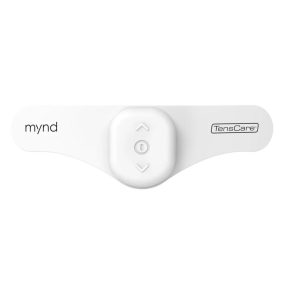Mynd: a migraine attack treatment and preventive cranial stimulator (CES) device.
Price includes: 1x Mynd device, 3x gel pads, 1x USB cable, 1x carrying bag
Migraine is a severe, recurrent headache often accompanied by other symptoms such as nausea, vomiting, and sensitivity to light or sound. Migraine differs from a typical headache in that it often involves a pulsating, throbbing pain and usually occurs on one side of the head. Attacks can last from a few hours up to several days.
Conventional medication-based treatments are useful for many, but they are not suitable for all patients due to side effects or contraindications. As a result, non-pharmacological interventions, such as cranial electrotherapy stimulation (CES), are gaining increasing attention in the treatment of migraine.
Causes of Migraine
The exact cause of migraine is not fully understood, but several factors may contribute to its development, including:
- Genetic predisposition: Migraine often runs in families.
- Neurochemical imbalances: Especially serotonin levels play an important role, affecting the function of cerebral blood vessels.
- Hormonal changes: Particularly in women, hormonal fluctuations (e.g., menstruation, pregnancy) often trigger migraine.
- Environmental factors: Stress, lack of sleep, fatigue, certain foods and drinks, bright lights, sounds, and odors can also be triggering factors.
Treatment Methods
Migraine treatment can be divided into two main types: acute and preventive treatments.
Acute treatment: The goal is to alleviate pain during an attack. Medications are most commonly used, which can be replaced or supplemented with CES stimulation.
Preventive treatment: As part of prevention, identifying and avoiding triggers plays an important role, and good results can also be expected from CES stimulation.
Other methods that can help reduce the frequency of migraines include:
- Regular sleep and adequate rest.
- Stress management, such as relaxation techniques or meditation.
- Healthy diet, avoiding migraine-triggering foods (e.g., chocolate, alcohol).
- Regular physical exercise.
CES (Cranial Electrotherapy Stimulation)
CES is a risk-free electrotherapy method that uses low-intensity electrical currents applied across the skull to influence brain activity.
An alternative treatment method that can avoid the side effects and risks of long-term medication use.
It is recommended for treating various conditions, such as:
- Chronic pain (e.g., migraine).
- Anxiety and depression: CES improves the balance of neurotransmitters in the brain, helping to manage mood disorders.
- Sleep disorders: CES may promote restful sleep by aiding relaxation of the nervous system.
CES can be a safe, side-effect-free alternative treatment for certain mental and physical issues, although its efficacy may vary between individuals.
Understanding Cranial Electrotherapy Stimulation (CES)
CES is a non-invasive neuromodulation technique that delivers low-intensity electrical currents to the brain (typically via electrodes placed on the earlobes or forehead).
The primary goal of CES is to modulate neuronal activity, thereby alleviating symptoms associated with various conditions, including anxiety, depression, insomnia, and pain disorders such as migraine.
The exact mechanisms by which CES works are still under investigation; however, it is believed to affect neurotransmitter levels and enhance neural plasticity, contributing to symptom relief.
Use of CES in Migraine Treatment
The use of CES in migraine treatment focuses on modulating pain pathways and reducing the frequency and intensity of migraine episodes. Studies have shown that CES can alter cortical excitability and influence trigeminal nerve pathways involved in migraine pathophysiology. A systematic review highlighted that various neuromodulation techniques, including CES, are promising for migraine prevention, although the quality of evidence varies and further research is needed.
TensCare Mynd Migraine Relief Device
The TensCare Mynd is a medically certified CES device specifically designed to relieve and prevent migraines.
This portable, rechargeable device delivers a low-intensity electrical current through adhesive gel pads placed on the forehead, targeting trigeminal nerve branches associated with migraine pain.
The device offers two modes: a treatment mode for acute migraine relief and a preventive mode to reduce the frequency and intensity of future attacks. Users can select from 40 intensity levels to tailor the therapy to their own comfort and therapeutic needs.



